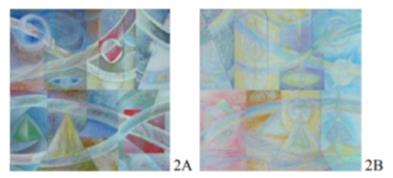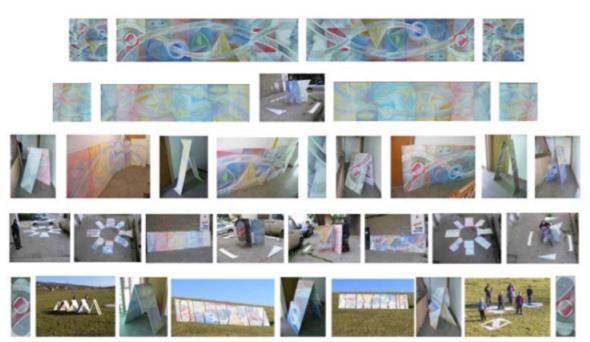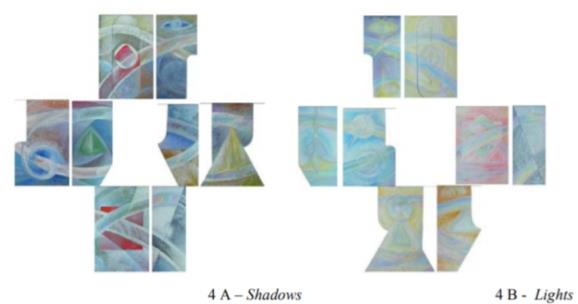Abstract
Our life is an educational
Keywords: Educational continuumimageinteractioncontextvisual artistic creationmodular paintings
Introduction
As an important presence in concrete and imagined realities, visual forms deserve a more extended
and deeper attention.
Located as we are between the microcosm and the macrocosm, in the visible surrounding world, we
constantly wonder about
microscopic to the macroscopic, on each of the three levels mentioned, joins the two; this resembles an
orchestra in which each level has a double status, that of
out as a soloist. Therefore, the beginning of form includes, in the seed, its diversity and transformation;
the diversity of the form implies a beginning and initiates the transformation; and the transformation of
separately. Visually, in fact and through their quintessence, they can be expressed either in harmony
and in disharmony. When dealing with the ecology of the visible, the forms that we propose or create
seem to feel that they have to assume a role of
public, the created forms acquire independent power; their relation to the viewers becomes creative in
itself, through the reactions they entice. In our time, in its moments of crisis and tension, human nature
might feel a stronger necessity, not to reverse visually only a dissipative result of some painful
emotions (with their psychological chain effects), but to try to counteract the tendencies to violence and
dislike by inducing a balance by means of plastic, stress-free, harmonious forms. Thus, as the design of
some configurations that also determine conceptual recoveries, the non-invasive visual symbols can
produce a state of spiritual elevation through their methods of artistic constitution.
This paper is based on its author’s own concept and artwork. Research conducted on a selection
from an extensive body of work resulted in a synthesis and several inferences shaped into a personal
visual artistic proposal: a modular
concept and visual-art ensemble present creative compositional paths both for artists and receivers; in
this interaction, the latter can become creators, through their thoughts, attitudes and actions.

The diversity of visual form
Purpose
The purpose of this work is to entice a need for visual knowledge, with a view to avoid the
destruction of form through violent actions and to stimulate rethinking, analytic decomposition and
artistic re-composition based on harmonious premises. This allows the cooperation of methods and a
balanced syncretism of the constituents involved. Therefore, original solutions, referencing fractals and
gesture extensions may appear widely; the incidence percentages of the ordering and random factors
determine the resulting artistic and visual aspects.
Objectives
The objectives of the
groups are people without professional artistic experience whose awareness can be raised towards the
diversity of visual artistic forms with reference to natural forms and to forms created by artists.
Methodologies and results
Enticing a taste for analysis and comparison of diverse visual forms can stimulate, at any age,
receptive mental attitudes, of contemplation and research, in nature, life and art. Simultaneously or as a
follow-up, creative actions are achievable both through initial ludic, free, entertaining approaches of
playing with visual forms, as well as through induced and proposed problem settings of approaching
and constituting groups of forms with certain meanings and also artistic solutions. The popularization
of a set of activities from the author’s own artistic creation, a set of works entitled
the plea for the aesthetically non-invasive
In his
artistic act gratuity, Herbert Read (Read 1971), states that art is an
form and beauty, and at the same time a
the entire creation process, from the idea that generated the artwork to the total number of language
means that shape the work – color, line, volume etc.
Our life is an educational
evidence and rigors. We live in a time ruled by the visual, in which images embrace, subdue and absorb
us.
Visual artistic creation correlates with the natural geographic and biological context and with the
historical, social, political, religious and cultural ones; this general context is echoed in the artwork as
the incidence of the environment over the artist. The visual forms through which the artists express
themselves are a result of the respective incidence, filtrated through the peculiarities of one’s own
personality; each artist seeks one’s own path through a cluster of virtual possibilities.
The path of shaping the forms that ultimately define a style can be found, in the process of time,
through successive, intuitive and/or deliberate explorations, in a theoretical and practical sense;
alternatively, it can appear as a derivative of a concept, pre-established in a certain time and space, an
ideational base that imposes certain regulations or rules of visualization (as in Ancient Egypt, for
instance). Most of the time, the two alternatives intertwine and the artist opts, unconditioned or
conditioned by circumstances, with varying degrees of subtlety, for a canon, current, fashion or style.
With references to
internationally), my proposal of
bidimensional modules, conceived and painted on both sides, were reshaped compositionally (photos in
Figure
interact with the painted ensemble of modules and enlarge the range of compositional altenatives, both
bidimensionally and tridimensionally; this extends the diversity of artistic expression. The idea is
inspired from the diversity of the visual form, natural and created by human beings, spontaneous and
deliberate.


The
pattern of forms and colours capable of generating other forms which, in their turn, can be assembled
from these components. Almost modules, but still not identical as form, they allow for different
assembling, in relation to one face or another, or with both of them at the same time. The result, that is
the re-shaping, plane or space stylization, allows for natural and man-made forms. Structurally, the
continuities and discontinuities of the composing forms can exist within the forms concurrently. The
opening of a wing, the rhythm of a wave, the approximation of a human silhouette, a tree, a mountain,
a butterfly, a cross form, a roof, a building, a boat, a book and other forms of images that could be
obtained from the
representations, with an indirect, allusive representation highlights the symbol as a means for the life of
ideas and stimulates of the perceptive and creative imagination. Thus, the symbolic configurations are
not only those obtained from the concept’s semantic inner structure towards the exteriorization to the
receptors, but also in the other way around: from the results of the associating the elements available
towards the mental re-creation of certain connotations, induced to the author of the works as well as to
the potential beholders-authors. This takes place exactly through the re-composition of plastic solutions
of some already formed forms.
However, these new forms are not cut-outs or variants or associations of borrowed artistic
visualizations, as they are personally conceived. The forms presented and recombined here remind one
of the post-modernist taste for compositional experiments, used as ways of creativity which visualize
and offer a semantic enrichment to some personal artistic suggestions. The idea of pictorial modules
offers the possibility for a variety of assemblies and shifts in connotation. The generalizing and
monumental, initially ludic
reveals a much closer meaning, through the same plastic elements as in the basic format, of a different
composition as compared to its primordial specific, visual and ideational semantics.
The Universe is reflected in us – in our physical and psychic structure, in our intrinsic order and
disorder - and its creation, in the rhythms, symmetries, asymmetries and everything that pulsates,
appears and transforms within each human being. Resonance logic is present everywhere in the visual
forms of reality and in those which make up the artistic aspects in time and space.

The painting that includes organic and angular forms from the
made on wooden panels using geometrical and stylized shapes. These shapes can be recomposed into a
square (Figure
rhythmical associations (Figure
The hypothesis can be applied, therefore, not only to painting, but also to sculpture and to the dynamic
possibilities of the programmed movement of some parts (through turns and balance for instance). In
this way, art and technicality merge into a visual performance in which borders between artistic
expressions are blurred. The dimensions of the forms may also vary, from monumental – aesthetic to
miniature – functional. The perception and artistic expression also uses the ludic state, irrespective of
the age of the viewer who might act upon it. Every work or piece from the
ensemble can be perceived both separately and in relation to the others. The sections or the painted
modular works have symbols with different semantics. They recompose and bring in new symbolism
and shape images suggestive of cosmic and earth aspects. The images convey the impression of
movement, continuity, of random and ordered situations, of rhythmic pulsation, of composition and
decomposition in diverse elements, with visual resemblances and differences. The name of the
works previously presented was derived from the very possibility of endless ways of reception of given
visual forms.
Conclusion
The fascination with the contemplation and shaping of form represents a perpetual challenge for a
visual artist. The initial stage in the ideation process of a creative act always embeds the primary forms,
the very forms from which the accomplishment of the artwork are gradually derived. The conceptual
and technical step an author chooses to take can represent, for another author, a step in the development
of their own different creative act.
Let us assume that we have some visual elements available. We can associate them in various
manners. Those imaginary
diversity, various overall images in which we find the same basic elements, displayed differently every
time. The impulse impression that art is supreme freedom is however an illusion. In the privacy of its
vast creative freedom, without subsidiary rigors or methods, without insistent study efforts or through
from search to discovery and assimilation of some expressions which can serve as a further base in the
differences in a personal sense, art cannot exist or impose itself as a rendering of an expressive
perfection.
For an artist, not just one accomplishment or another is a
full, has a form that fits into
themselves time to fathom these forms and find out that in this way they, the viewers, shape themselves
culturally. In so doing they add to the knowledge around themselves, as they transmit what they have
received and rediscover an increasing number of interpretations. Therefore, what has already been
mentioned is restated and every time the form of rendering is enriched with new hypostases.
To conclude, artistic forms also imply a comprehensive view, which can expand the analysis from
the independent, abstract mode of the structuring of form itself to the at least minimal interaction with
other fields of human life and knowledge. Resonance logic is present everywhere in the visual forms of
reality and in those which create the artistic aspects in time and space.
Acknowledgment
Figures
References
- Read, H. (1971). Originile formei în artă [The origins of form in Art]. Bucharest: Univers Publishing House.
Copyright information

This work is licensed under a Creative Commons Attribution-NonCommercial-NoDerivatives 4.0 International License.
About this article
Publication Date
04 October 2016
Article Doi
eBook ISBN
978-1-80296-014-3
Publisher
Future Academy
Volume
15
Print ISBN (optional)
-
Edition Number
1st Edition
Pages
1-1115
Subjects
Communication, communication studies, social interaction, moral purpose of education, social purpose of education
Cite this article as:
Dominte, G. M. (2016). The Diversity of the Visual Form. In A. Sandu, T. Ciulei, & A. Frunza (Eds.), Logos Universality Mentality Education Novelty, vol 15. European Proceedings of Social and Behavioural Sciences (pp. 305-310). Future Academy. https://doi.org/10.15405/epsbs.2016.09.39

